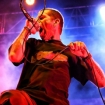Some visual artists will forever be associated with specific bands — and, as Derek Riggs will always be identified with Iron Maiden, so Paul Romano is inseparable from Mastodon. That's how the strong an impression his cover art for the band's 2002 album, Remission — which artist Richey Beckett has called his favorite cover art of that decade — and its follow-up, Leviathan, made in the metal world and beyond. But Romano has lent his vision to many other groups and projects over the years, including Trivium, the Red Chord, A Life Once Lost and the Acacia Strain. We caught up with Romano to get the lowdown on his process and inspiration.
REVOLVER What is your artistic background?
PAUL ROMANO I grew up in Philadelphia and was enrolled at a pretty young age in Saturday classes at the local art schools: Pennsylvania Academy of Fine Art, and The University of the Arts. Mainly I studied anatomy and life drawing in my pre-college years. During college—I went to both of those schools mentioned—my mainstay was drawing and painting but I jumped around quite a bit gathering up all that I could: printmaking, photography, and bits of woodworking and metalsmithing.
How long have you been creating album covers for metal bands?
I switched gears from more corporate work around 2001. It was just time… At first I did odds and ends for Relapse Records: fixing up their magazine, Resound, and various layouts. I got a copy of the Mastodon demo that was floating around the office and freaked out… Mastodon's Remission was the first where I handled everything: logo, art direction, artwork, and design.

What materials do you use?
I run the gamut: graphite, charcoal, ink, watercolor, gouche, acrylic, oil. I have done sculptural works for projects; built dioramas. I've constructed entire rooms of my home for album artwork. These things end up as photographs, which I also take. I do get involved with photo processes a lot. I print my own usually in a method called cyanotype or another called gum bichromate. I am certain most folks believe these works to be digital and honestly the "look" is easily achieved in Photoshop but not the accidents. I really enjoy the accidents in printing my photos in these processes.
How long does it take you to complete a piece?
I have finished works in a day and others can take months.
What sort of things do you use for inspiration?
The usual stuff I think. Music, of course, is a huge inspiration. I do read tons: art history, science, psychology, and occasionally fiction. The internet plays a good role. I check a handful of blogs and design sites, scouring over the endless images provided. I watch a good amount of movies/film.
How much input do you have into the ideas behind the work?
I won't take a project if the client has a fully formed idea; I am not interested in simply being a set of skilled hands.
What musicians have you worked with in the past?
Mastodon, Hate Eternal, Withered, dälek, Starkweather, Trivium, A Life Once Lost, the Red Chord, Through the Eyes of the Dead, the Acacia Strain, Jedi Mind Tricks, Chiodos, Ion Dissonance, None More Black, Animosity, Earth Crisis, Godflesh, Fear Factory, and a bunch more. I've worked on about 200 albums and even more merch to date.
What piece are you most proud of and why?
This is a difficult one. I can tell you about a project that I enjoyed quite a bit. The Red Chord's Clients holds some great memories. The process involved in creating those works started with portraits of the band members as well as the actual people the record was written about. I wanted to reference Victorian portrait and ideas of criminology from that time period. Criminologists from that time thought that you could build up a database of sorts by photographing criminals and details of their parts—eyes, mouth, ears, and such. In turn you could then use this reference guide to profile criminals out in the world based upon similarity of features to known criminals. Pretty amusing. That was









